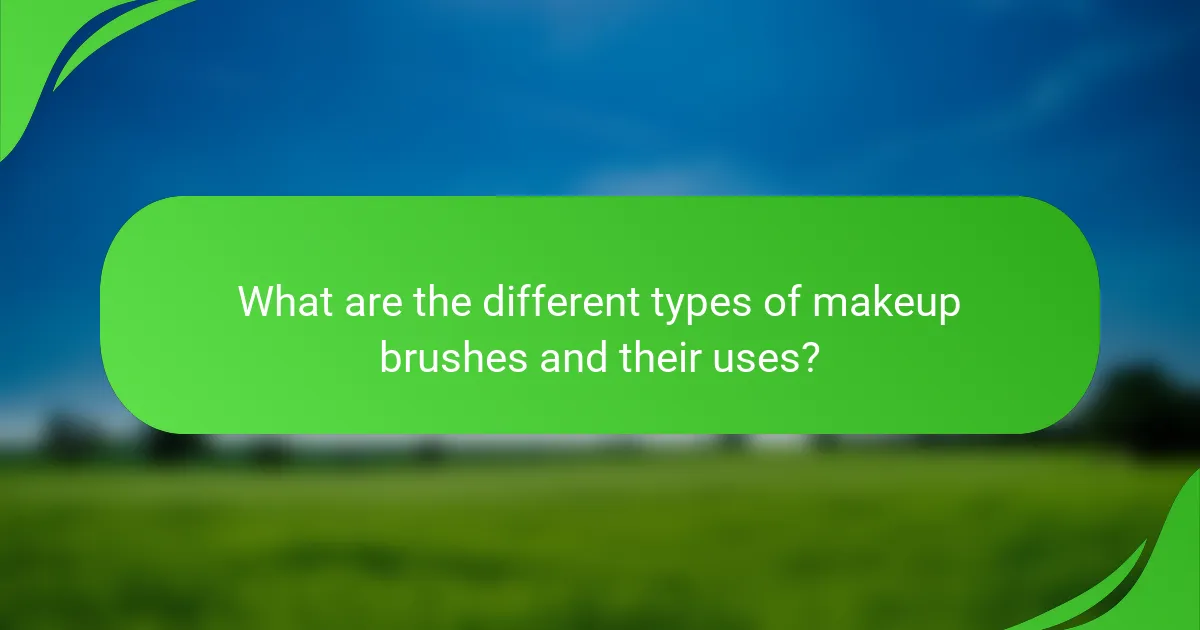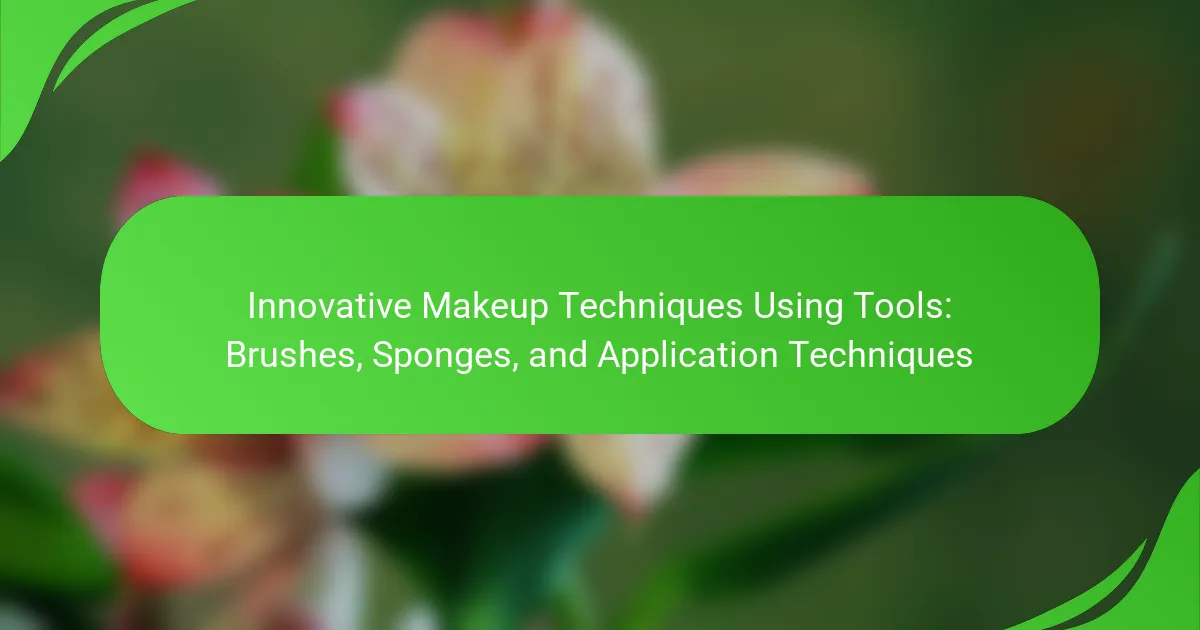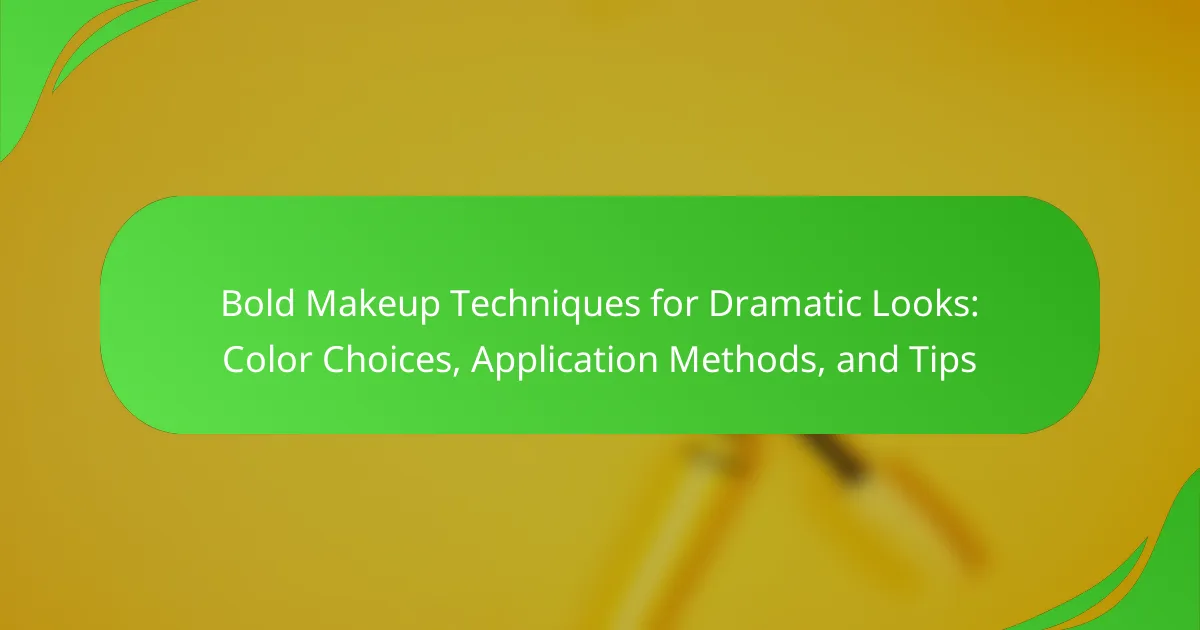The article focuses on innovative makeup techniques using tools such as brushes, sponges, and beauty blenders to enhance application and finish. Key techniques include stippling for a soft-focus effect, damp sponge application for a dewy finish, and airbrush makeup for a lightweight look. Various brush types are discussed, highlighting their specific purposes, including foundation, powder, blush, eyeshadow, eyeliner, and lip brushes. Additionally, the article covers effective usage practices for makeup tools, including selection, cleaning, and application techniques to improve overall makeup quality and precision.

What are Innovative Makeup Techniques Using Tools?
Innovative makeup techniques using tools include various methods that enhance application and finish. Tools such as brushes, sponges, and beauty blenders are central to these techniques. For example, stippling with a brush creates a soft-focus effect. Using a damp sponge can provide a dewy finish for foundation. Airbrush makeup offers a flawless, lightweight application that is popular for special occasions. Silicone applicators allow for smooth and even distribution of products. Additionally, using fan brushes can create a natural highlight effect. These techniques improve precision and overall makeup quality.
How do brushes, sponges, and application techniques enhance makeup application?
Brushes, sponges, and application techniques significantly enhance makeup application by improving precision and blending. Brushes allow for detailed application, enabling users to target specific areas like the eyes and contour. Sponges provide a seamless finish by blending products into the skin for a natural look. Various application techniques, such as stippling or buffing, further enhance the evenness of product distribution. Research indicates that using the right tools can reduce the amount of product needed, promoting efficiency. Additionally, the texture and shape of brushes and sponges can create different effects, such as a dewy finish or full coverage. Proper tool selection is essential for achieving desired makeup results.
What types of brushes are essential for innovative makeup techniques?
Essential brushes for innovative makeup techniques include foundation brushes, stippling brushes, and blending brushes. Foundation brushes provide an even application of liquid or cream products. Stippling brushes create a soft, airbrushed finish by using a light tapping motion. Blending brushes are crucial for seamlessly blending eyeshadows and achieving a gradient effect. Additionally, contour brushes help define [censured] features by applying and blending contour products. Highlighting brushes are designed for precise application of highlighters to accentuate the cheekbones. Each brush type serves a unique purpose, enhancing the overall makeup application process.
How do sponges differ from brushes in makeup application?
Sponges and brushes differ significantly in makeup application techniques. Sponges provide a more seamless finish by blending products into the skin. They absorb some product, which can create a natural look. Brushes, on the other hand, offer more control and precision during application. They are ideal for layering and defining specific areas. The texture of sponges can lead to a dewy finish, while brushes can create a more matte appearance. Each tool serves different purposes depending on the desired makeup effect.
What application techniques are considered innovative in the makeup industry?
Innovative application techniques in the makeup industry include airbrushing, strobing, and baking. Airbrushing uses a compressor and airbrush gun to apply foundation for a flawless finish. This technique is often used in professional settings for its ability to create a smooth, even layer. Strobing emphasizes the high points of the face with highlighter, creating a dewy effect. It gained popularity as a simpler alternative to contouring. Baking involves applying a thick layer of setting powder to areas of the face and letting it sit to set makeup. This technique enhances longevity and prevents creasing. Each of these methods has transformed makeup application, offering new ways to achieve desired looks.
Why are tools important in achieving flawless makeup looks?
Tools are important in achieving flawless makeup looks because they enhance precision and application. The right brushes and sponges distribute products evenly. This leads to a smoother finish and better blending. For example, a foundation brush can create an airbrushed look. Similarly, beauty sponges can help achieve a natural, dewy finish. Studies show that using proper tools can significantly improve makeup longevity. Tools also reduce the risk of skin irritation by providing a barrier between fingers and products. Ultimately, the quality of tools directly impacts the overall makeup result.
How do the right tools impact the blending and finishing of makeup?
The right tools significantly enhance the blending and finishing of makeup. High-quality brushes and sponges allow for smoother application and better product distribution. For instance, dense brushes can create a flawless foundation finish. Meanwhile, sponges are excellent for blending cream products seamlessly into the skin. The shape and material of the tools also influence the outcome. A damp sponge can provide a dewy finish, while dry brushes may result in a more matte look. Research shows that proper tool selection can improve makeup longevity and appearance. A study by the Journal of Cosmetic Science highlights that tool quality directly correlates with user satisfaction in makeup application.
What are the benefits of using high-quality makeup tools?
High-quality makeup tools enhance application and overall makeup performance. They provide better precision for makeup placement. This leads to a more polished and professional look. High-quality brushes and sponges blend products seamlessly. They minimize streaks and patchiness on the skin. Additionally, these tools often use superior materials. This results in improved durability and longevity. Investing in quality tools can also save money over time. They reduce the need for frequent replacements. Studies show that using professional-grade tools improves makeup longevity. This ensures that makeup stays intact throughout the day.

What are the different types of makeup brushes and their uses?
Makeup brushes come in various types, each serving specific purposes. Foundation brushes are designed for applying liquid or cream foundations evenly. Powder brushes are used to apply loose or pressed powder for a matte finish. Blush brushes help in applying blush to the cheeks for a natural flush. Eyeshadow brushes vary in size and shape, allowing for precise application and blending of eyeshadows. Eyeliner brushes are fine-tipped for detailed application of gel or liquid liners. Lip brushes provide precision in applying lipstick or lip gloss. Each brush type is crafted to enhance makeup application techniques effectively.
What are the key categories of makeup brushes?
The key categories of makeup brushes include face brushes, eye brushes, and lip brushes. Face brushes are designed for applying foundation, blush, and powder. They come in various shapes and sizes for different applications. Eye brushes are used for eyeshadow, eyeliner, and blending. These brushes also vary in size and shape to achieve specific looks. Lip brushes are specifically made for applying lip color with precision. Each category serves a distinct purpose in makeup application.
How do synthetic brushes compare to natural hair brushes?
Synthetic brushes are generally more versatile and easier to clean than natural hair brushes. Synthetic bristles are made from nylon or polyester, which allows for a variety of applications. They are non-porous, making them suitable for liquid and cream products. Natural hair brushes, made from animal hair, excel with powder products due to their ability to pick up and distribute pigments effectively. Synthetic brushes tend to be more durable and resistant to shedding compared to their natural counterparts. Additionally, synthetic brushes are often more affordable and cruelty-free, appealing to a broader audience. Studies have shown that synthetic brushes can provide a similar finish to natural brushes when used correctly.
What specific brushes are best for foundation application?
The best brushes for foundation application include flat foundation brushes, buffing brushes, and stippling brushes. Flat foundation brushes provide a smooth application of liquid foundations. Buffing brushes are ideal for blending cream and liquid foundations seamlessly into the skin. Stippling brushes create an airbrushed finish by layering product without streaks. These brushes are designed to enhance the application process, ensuring an even and flawless look. According to makeup artists, using the right brush can significantly affect the foundation’s finish and longevity on the skin.
How can the shape and size of brushes affect makeup application?
The shape and size of brushes significantly impact makeup application. Different brush shapes, such as flat, angled, or rounded, are designed for specific tasks. Flat brushes are ideal for applying foundation evenly. Angled brushes help with contouring by fitting the natural curves of the face. Rounded brushes are effective for blending products seamlessly.
Brush size also plays a crucial role. Smaller brushes allow for precise application in detailed areas like the eyes. Larger brushes cover more surface area quickly, making them suitable for applying powder or bronzer.
The right combination of shape and size enhances the overall finish of makeup. According to a study published in the Journal of Cosmetic Science, proper brush selection can improve product distribution and reduce makeup wastage.
What are the benefits of using angled brushes for contouring?
Angled brushes for contouring provide precision and control in makeup application. Their unique shape allows for easy access to contour areas, such as the hollows of the cheeks and jawline. This design helps in blending products seamlessly, creating a natural look. Angled brushes can also define [censured] features more effectively than flat brushes. The bristles are often densely packed, which aids in picking up and depositing product evenly. Using an angled brush can reduce the time spent blending, resulting in a quicker makeup routine. Studies show that the right tools can enhance makeup application quality, making angled brushes a preferred choice among makeup artists.
How does the size of a brush influence precision in application?
The size of a brush significantly influences precision in application. Smaller brushes allow for more detailed work, such as applying eyeshadow or eyeliner. They can reach tight spaces and create sharp lines. Larger brushes are better suited for broader strokes and blending. This size differentiation affects the control an artist has during application. Research indicates that brush size impacts the distribution of product on the skin. A study published in the Journal of Cosmetic Science found that smaller brushes lead to more controlled and accurate application. This evidence supports the assertion that brush size is crucial for achieving desired makeup effects.

What innovative techniques can be applied with sponges?
Innovative techniques that can be applied with sponges include stippling, damp application, and multi-layering. Stippling involves using a sponge to create a textured finish by dabbing the product onto the skin. This technique allows for a more natural look by blending foundation seamlessly. Damp application enhances the product’s blendability and hydration. Wetting the sponge before use helps to achieve a dewy finish. Multi-layering allows for buildable coverage, applying thin layers of product for a customized look. Each technique leverages the sponge’s unique texture and absorption properties to enhance makeup application.
How can beauty sponges be used for different makeup products?
Beauty sponges can be used for various makeup products including foundation, concealer, and blush. For foundation, a damp beauty sponge provides an airbrushed finish. The sponge absorbs excess product while blending seamlessly into the skin. When applying concealer, the sponge’s pointed tip allows for precise placement in hard-to-reach areas. This technique helps to cover blemishes and dark circles effectively. For cream blush, a beauty sponge can create a natural flush. The sponge’s texture blends the product into the skin without streaks. Additionally, beauty sponges can be used for setting powders. A dry sponge can press powder into the skin for a matte finish. Each application method utilizes the sponge’s unique shape and texture for optimal results.
What techniques enhance the use of sponges for foundation and concealer?
Dampening the sponge enhances its use for foundation and concealer. A damp sponge allows for smoother application and better blending. The moisture helps to hydrate the skin, creating a dewy finish. Using a stippling motion with the sponge improves coverage without caking. Pressing the sponge into the skin allows for a natural look. Additionally, using a clean sponge prevents product buildup and bacteria. Rotating the sponge during application ensures even distribution of product. These techniques collectively improve the overall finish and longevity of makeup.
How does the dampness of a sponge affect makeup application?
A damp sponge enhances makeup application by providing a smoother, more even finish. The moisture in the sponge helps to blend products seamlessly into the skin. This results in a more natural appearance compared to using a dry sponge. Additionally, a damp sponge can prevent makeup from being absorbed too much, allowing for better pigmentation. Studies show that using a damp sponge can reduce the appearance of texture on the skin. This technique is widely recommended by makeup artists for achieving a flawless look.
What are some common mistakes when using sponges?
Common mistakes when using sponges include not wetting the sponge before application. A dry sponge absorbs more product, leading to uneven coverage. Another mistake is using the sponge for too long without cleaning it. This can lead to bacteria buildup, causing skin issues. Additionally, applying too much pressure can result in streaks and a patchy finish. Not using the right type of sponge for the product can also hinder application. For example, a dense sponge may not blend liquid foundation effectively. Lastly, neglecting to replace old sponges can affect makeup application quality. Regularly replacing sponges ensures optimal performance and hygiene.
How can users avoid streaks and uneven application with sponges?
Users can avoid streaks and uneven application with sponges by using a damp sponge. A damp sponge helps to blend makeup more smoothly. It prevents the sponge from absorbing too much product. Users should also apply foundation in thin layers. This method allows for better build-up and blending. Using a stippling motion rather than dragging helps achieve an even finish. Additionally, users should clean their sponges regularly to remove product buildup. A clean sponge ensures that makeup goes on evenly. Following these techniques leads to a flawless application.

What are the best practices for using makeup tools effectively?
To use makeup tools effectively, start by selecting the right tool for each product. Brushes are ideal for powder products, while sponges work well with liquids and creams. Clean your tools regularly to prevent bacteria buildup and ensure smooth application. Use gentle, circular motions when applying makeup with brushes for an even finish. For sponges, dampen them before use to achieve a more blended look. Store tools in a clean, dry place to maintain their shape and hygiene. Lastly, replace worn-out tools to ensure optimal performance. These practices enhance makeup application and improve overall results.
How should brushes and sponges be cleaned and maintained?
Brushes and sponges should be cleaned regularly to maintain their performance and hygiene. For brushes, use warm water and a gentle soap or brush cleaner. Swirl the brush in the solution and rinse until the water runs clear. Allow brushes to air dry flat to prevent damage. For sponges, wet the sponge and apply a small amount of soap. Squeeze and rinse thoroughly until clean. Replace sponges every few months for optimal results. Regular cleaning prevents bacteria build-up and extends the lifespan of these tools.
What cleaning products are safe for makeup tools?
Mild soap and water are safe for cleaning makeup tools. Antibacterial dish soap is effective for brushes and sponges. Isopropyl alcohol can sanitize tools without damaging them. Baby shampoo is gentle and helps maintain bristle integrity. Vinegar mixed with water can also serve as a natural cleaner. These products effectively remove makeup residue and bacteria. Regular cleaning prevents skin irritation and prolongs tool lifespan.
How often should makeup tools be replaced for optimal performance?
Makeup tools should be replaced every three to six months for optimal performance. Regular replacement ensures that tools maintain their effectiveness and hygiene. Brushes can accumulate bacteria and product buildup, which may affect application quality. Sponges should be replaced more frequently, ideally every one to three months, due to their porous nature. Using worn-out tools can lead to uneven application and skin irritation. Maintaining a schedule for replacement helps achieve a flawless makeup look.
What tips can enhance the application techniques of makeup tools?
Use clean, high-quality makeup tools for optimal results. Quality tools ensure even application and better blending. For brushes, select the right shape for the area being worked on. Flat brushes are ideal for foundation, while fluffy brushes work well for blending.
Dampen sponges before use to achieve a more natural finish. This technique helps the sponge absorb less product, allowing for a smoother application. Use stippling motions with sponges for a seamless blend.
Practice proper cleaning techniques for tools to maintain hygiene and performance. Regular cleaning prevents bacteria buildup and prolongs the life of the tools.
Experiment with different techniques, such as tapping or swirling, to find what works best for your skin type. Adjusting pressure and angle can also influence the application outcome.
How can layering techniques improve the overall makeup look?
Layering techniques can enhance the overall makeup look by creating depth and dimension. This method involves applying multiple products in thin layers rather than one thick application. Each layer can add different textures and finishes, such as matte or dewy. For instance, layering foundation with a tinted moisturizer can provide a natural glow. Additionally, using layering for eyeshadows can intensify color payoff and create more complex looks. Studies show that layered makeup can last longer throughout the day, maintaining a fresh appearance. Proper layering also helps in achieving a more blended and seamless finish, reducing harsh lines.
What are some troubleshooting tips for common makeup application issues?
For common makeup application issues, start by identifying the problem. If foundation appears cakey, use a damp sponge to blend it out. For uneven eyeshadow, apply a primer for better adherence. If eyeliner smudges, set it with translucent powder. For dry skin, use a hydrating primer before foundation. If mascara clumps, comb through lashes with a clean spoolie. For lipstick feathering, apply a lip liner to define the edges. If blush looks too harsh, blend with a clean brush or sponge. Each tip addresses specific application challenges effectively.
Innovative makeup techniques using tools focus on enhancing makeup application through the use of brushes, sponges, and various application methods. Key topics include the types of brushes essential for different makeup tasks, the unique advantages of sponges versus brushes, and innovative application techniques like airbrushing and baking. The article also covers best practices for using and maintaining makeup tools, including cleaning methods and replacement schedules, to ensure optimal performance and hygiene. Overall, the content provides a comprehensive overview of how the right tools and techniques can significantly improve makeup application quality and results.


